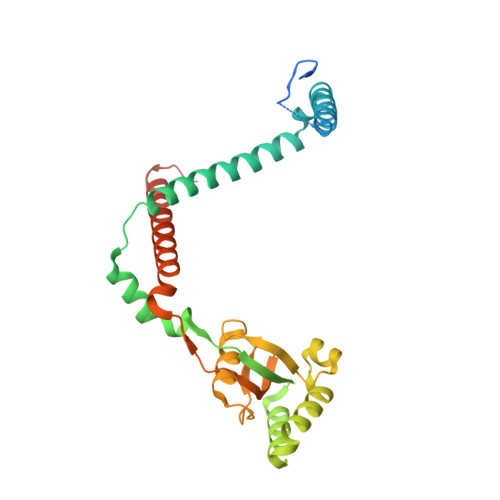Helicobacter pylori cell binding factor 2: Insights into domain motion.
Naveen, V., Chu, C.H., Chen, B.W., Tsai, Y.C., Hsiao, C.D., Sun, Y.J.(2016) J Struct Biol 194: 90-101
- PubMed: 26850168
- DOI: https://doi.org/10.1016/j.jsb.2016.02.002
- Primary Citation of Related Structures:
5EZ1 - PubMed Abstract:
Helicobacter pylori cell binding factor 2 (HpCBF2) is an antigenic virulence factor belonging to the SurA-like peptidyl-prolyl cis-trans isomerase family with implications for pathogenicity in the human gastrointestinal tract. HpCBF2 possesses PPIase activity and could act as a periplasmic chaperone to regulate outer membrane protein assembly. Here, we measured the isomerization and chaperone activity of HpCBF2, and determined the crystal structure of HpCBF2 in complex with an inhibitor, indole-2-carboxylic acid (I2CA), at 2.4? resolution. HpCBF2-I2CA forms a homodimer encasing a large central hydrophobic cavity with a basket-like structure, and each monomer contains a PPIase and a chaperone domain. In the HpCBF2-I2CA dimer, the two PPIase domains separate by a distance of 22.8?, while the two chaperone domains arrange in a domain-swap manner. The PPIase domains bound with I2CA ligand face towards the chaperone domains and are shielded by surrounding hydrophobic residues. With the aid of SAXS experiments, we also revealed domain motion between the apo- and I2CA-bound states of HpCBF2. The domain motion in HpCBF2 might be necessary for the isomerization activity of PPIase and the accommodation of the unfolded and partially folded peptides to refold by chaperone domain.
Organizational Affiliation:
Molecular Cell Biology, Taiwan International Graduate Program, Graduate Institute of Life Sciences, National Defense Medical Center and Academia Sinica, Taipei 115, Taiwan; Institute of Molecular Biology, Academia Sinica, Taipei 115, Taiwan.















